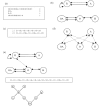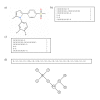A constructive approach for discovering new drug leads: Using a kernel methodology for the inverse-QSAR problem
- PMID: 20142987
- PMCID: PMC2816860
- DOI: 10.1186/1758-2946-1-4
A constructive approach for discovering new drug leads: Using a kernel methodology for the inverse-QSAR problem
Abstract
Background: The inverse-QSAR problem seeks to find a new molecular descriptor from which one can recover the structure of a molecule that possess a desired activity or property. Surprisingly, there are very few papers providing solutions to this problem. It is a difficult problem because the molecular descriptors involved with the inverse-QSAR algorithm must adequately address the forward QSAR problem for a given biological activity if the subsequent recovery phase is to be meaningful. In addition, one should be able to construct a feasible molecule from such a descriptor. The difficulty of recovering the molecule from its descriptor is the major limitation of most inverse-QSAR methods.
Results: In this paper, we describe the reversibility of our previously reported descriptor, the vector space model molecular descriptor (VSMMD) based on a vector space model that is suitable for kernel studies in QSAR modeling. Our inverse-QSAR approach can be described using five steps: (1) generate the VSMMD for the compounds in the training set; (2) map the VSMMD in the input space to the kernel feature space using an appropriate kernel function; (3) design or generate a new point in the kernel feature space using a kernel feature space algorithm; (4) map the feature space point back to the input space of descriptors using a pre-image approximation algorithm; (5) build the molecular structure template using our VSMMD molecule recovery algorithm.
Conclusion: The empirical results reported in this paper show that our strategy of using kernel methodology for an inverse-Quantitative Structure-Activity Relationship is sufficiently powerful to find a meaningful solution for practical problems.
Figures






















Similar articles
-
Predicting multiple binding modes using a kernel method based on a vector space model molecular descriptor.Int J Comput Biol Drug Des. 2009;2(1):58-80. doi: 10.1504/ijcbdd.2009.027584. Int J Comput Biol Drug Des. 2009. PMID: 20054986
-
Exploring differential evolution for inverse QSAR analysis.F1000Res. 2017 Jul 31;6:Chem Inf Sci-1285. doi: 10.12688/f1000research.12228.2. eCollection 2017. F1000Res. 2017. PMID: 28928936 Free PMC article.
-
Using kernel alignment to select features of molecular descriptors in a QSAR study.IEEE/ACM Trans Comput Biol Bioinform. 2011 Sep-Oct;8(5):1373-84. doi: 10.1109/TCBB.2011.31. IEEE/ACM Trans Comput Biol Bioinform. 2011. PMID: 21339534
-
Feature selection methods in QSAR studies.J AOAC Int. 2012 May-Jun;95(3):636-51. doi: 10.5740/jaoacint.sge_goodarzi. J AOAC Int. 2012. PMID: 22816254 Review.
-
Quantitative Structure-Activity Relationships of Aquatic Narcosis: A Review.Curr Comput Aided Drug Des. 2018;14(1):7-28. doi: 10.2174/1573409913666170711130304. Curr Comput Aided Drug Des. 2018. PMID: 28699497 Review.
Cited by
-
Rethinking drug design in the artificial intelligence era.Nat Rev Drug Discov. 2020 May;19(5):353-364. doi: 10.1038/s41573-019-0050-3. Epub 2019 Dec 4. Nat Rev Drug Discov. 2020. PMID: 31801986 Review.
-
Artificial Intelligence in De novo Drug Design: Are We Still There?Curr Top Med Chem. 2022;22(30):2483-2492. doi: 10.2174/1568026623666221017143244. Curr Top Med Chem. 2022. PMID: 36263480 Review.
-
Quantum Chemistry Calculations for Metabolomics.Chem Rev. 2021 May 26;121(10):5633-5670. doi: 10.1021/acs.chemrev.0c00901. Epub 2021 May 12. Chem Rev. 2021. PMID: 33979149 Free PMC article. Review.
-
Who Is Metabolizing What? Discovering Novel Biomolecules in the Microbiome and the Organisms Who Make Them.Front Cell Infect Microbiol. 2020 Jul 31;10:388. doi: 10.3389/fcimb.2020.00388. eCollection 2020. Front Cell Infect Microbiol. 2020. PMID: 32850487 Free PMC article.
-
Bayesian molecular design with a chemical language model.J Comput Aided Mol Des. 2017 Apr;31(4):379-391. doi: 10.1007/s10822-016-0008-z. Epub 2017 Mar 9. J Comput Aided Mol Des. 2017. PMID: 28281211 Free PMC article.
References
-
- Sharp KA. Potential functions for virtual screening and ligand binding calculations: Some theoretical considerations . In: Alvarez J, Shoichet B, editors. Virtual Screening in Drug Discovery. New York: Taylor & Francis; 2005. pp. 229–248.
-
- Todeschini R, Consonni V. Handbook of molecular descriptors. Weinheim: Wiley-VCH; 2000.
LinkOut - more resources
Full Text Sources
Other Literature Sources

